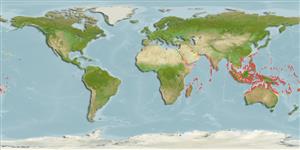Preferred temperature (Ref.
115969): 26.1 - 29.3, mean 28.5 (based on 2234 cells).
Fylogenetische diversiteitsindex (Ref.
82804): PD
50 = 0.5000 [Uniqueness, from 0.5 = low to 2.0 = high].
Bayesian length-weight: a=0.01380 (0.00670 - 0.02842), b=3.00 (2.83 - 3.17), in cm Total Length, based on LWR estimates for this Genus-body shape (Ref.
93245).
Trofisch niveau (Ref.
69278): 3.9 ±0.6 se; based on size and trophs of closest relatives
Weerstandsvermogen (Ref.
120179): laag, minimale populatieverdubbelingstijd 4,5-14 jaar (Preliminary K or Fecundity.).
Fishing Vulnerability (Ref.
59153): High vulnerability (55 of 100).
